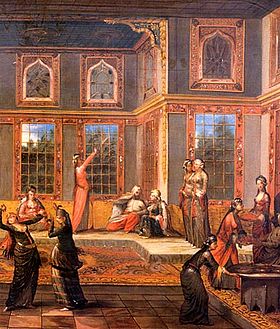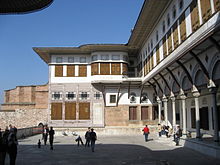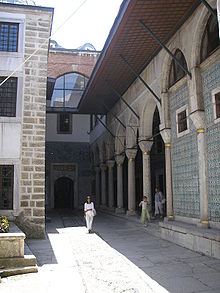- Imperial Harem
-
The Imperial Harem (Turkish, Harem-i Hümâyûn) of the Ottoman Empire (1299-1923) was one of the most important elements of the Ottoman court. It was known in the West as "the Seraglio", an Italian term.
Contents
Harem quarters
The Imperial Harem occupied one of the large sections of the private apartments of the sultan at the Topkapi Palace which encompassed more than 400 rooms. After 1853, an equally lavish harem quarter was occupied at the new imperial palace at Dolmabahçe.
Harem administration
Role of the Valide Sultan ("Queen Mother")
The mother of a new Sultan came to the harem with pomp and circumstance and assumed the title of Queen Mother (Valide Sultan) upon her son's ascension. She was paramount chief and ran the Harem and ruled over the members of the dynasty. The Valide Sultan who influenced the political life of the Ottoman Empire during various periods of history had the authority to regulate the relations between the sultan and his wives and children. The Valide Sultan was a majestic symbol of the Ottoman dynasty and wielded great power.
Role of the concubines
For the perpetuation of the Ottoman Dynasty and service to it, beautiful and intelligent slave girls were either captured in war (mainly Christian Europeans in the Balkans), recruited within the empire, or procured from neighbouring countries to become imperial concubines (Cariyes). The concubines who were introduced into the Harem in their tender age were brought up in the disciplines of the Palace. They were promoted according to their capacities and became kalfas and ustas. The concubine with whom the Sultan shared his bed became a member of the dynasty and rose in rank to attain the status of Gözde (the Lucky), Ikbal (the Favourite) or Kadın (the Wife). The highest position herself was the Queen Mother (Valide Sultan), the mother of the Sultan, who herself used to be a concubine of the Sultan’s father and rose to the supreme rank in the Harem. No concubine could leave or enter the premises of the Harem without the explicit permission of the Queen Mother. The power of the Queen Mother over concubines even extended to questions of life and death, with eunuchs directly reporting to her. The concubines either lived in the halls beneath the apartments of the consorts, the Queen Mother and the Sultan, or in separate chambers. The kadıns, who numbered four, formed the group who came next in rank to the Queen Mother. Right below the kadins in rank were the ikbals, whose number was unspecified. Last in the hierarchy were the gözdes. The favourite consort who was the mother of the crown prince, as well as the other kadıns, enjoyed a privileged position in the hierarchy of the harem.
Role of the eunuchs
At Topkapı Palace, at the court of the Ottoman sultans, the harem staff commonly included eunuchs. These were slaves, either captured in war (mainly Christian Europeans in the Balkans) or recruited within the empire (especially from the Caucasus and blacks from Sudan) or even beyond (especially in Abyssinia). Black eunuchs usually were Sandali (i.e. their genitalia were entirely amputated), hence they were preferred for harem service, while White eunuchs usually kept part of their penis and/or testicles, so they were assigned to less 'intimate' duties, e.g. secretarial. They were often donated to the Sultan by his governors, in total about six- to eight hundred.
The castrated servicemen in the Muslim and Turkish states in the Middle Ages were recruited to serve in the palace from the times of Sultan Mehmed I onwards. These eunuchs who were trained in the palace and were given the charge of guarding the harem rose in rank after serving in many positions. The harem eunuchs and the harem organisation were under the command of the Chief harem eunuch, who was also called the Master of the Girls (Kızlar Ağasi) or Chief Black Eunuch. They supervised the quarters where the female population of the palace lived. They had influence on the palace and later on the state administration in the 17th and 18th centuries as they had access to the sultan and the sultan's family and became very powerful. Eunuchs at the Ottoman court were preferably taken from Africa, especially Sudan.
The Chief Black Eunuch was sometimes considered second only to the Grand Vizier (head of the imperial government, but often working in his own palace or even away, e.g., on military campaign) in the confidence of the Sultan, to whom he had and arranged access (including his bedchamber, the ne plus ultra for every harem lady), also being his confidential messenger. As commander of an imperial army corps, the halberdiers (baltaci), he even held the supreme military dignity of three-tail pasha (general).
Meanwhile the Chief White Eunuch (Kapı Ağasi), was in charge of 300 to 900 white eunuchs as head of the 'Inner Service' (the palace bureaucracy, controlling all messages, petitions, and State documents addressed to the Sultan), head of the Palace School (school for pages training as white eunuchs), gatekeeper-in-chief, head of the infirmary, and master of ceremonies of the Seraglio, and was originally the only one allowed to speak to the Sultan in private. In 1591, Murad III transferred the powers of the white to the black eunuchs as there was too much embezzlement and various other nefarious crimes attributed to the white eunuchs, but later they regained some favour.
During the Sultanate of Women (Kadınlar Sultanati), the eunuchs increased their political leverage by taking advantage of minor or mentally incompetent Sultans, causing political instability. The teenage Sultans were "guided" by regencies formed by the Queen Mother (Valide Sultan), the Grand Vizier and the Valide's other supporters- and the Chief Black Eunuch was the Queen Mother's and Chief Consorts' intimate and valued accomplice.
Golden Cage
The Ottoman harem was often called "the golden cage". After Ahmed III's reformation of the law of succession to Ottoman throne and decline of sancağa çıkma (system with young princes working as governors of distant cities in order for them to learn how to rule a country), male princely heirs began to live in a part of the palace that was called kafes, which translates as "cage" from Ottoman Turkish. Here the princes had to live in seclusion until they were either executed so as not be a threat to the crown prince, or be released once they became sultans. This change had a very negative effect on quality and abilities of later Ottoman sultans.
See also
References
Citations
Other sources
- İlhan Akşit. The Mystery of the Ottoman Harem. Akşit Kültür Turizm Yayınları. ISBN 975-7039-26-8
External links
State organisation of the Ottoman Empire Central System
(Military administration)Government:Grand Vizier (list) · Viziers · Finance
Provincial System
(Civil administration)CentralMillets (Muslims (Sheikh ul-Islam) · Christians (Orthodox Patriarch · Armenian Patriarch · Syriac Orthodox) · Jews)LocalCategories:- Harem
- Topkapı Palace
- Culture of the Ottoman Empire
- Ottoman slaves
Wikimedia Foundation. 2010.





